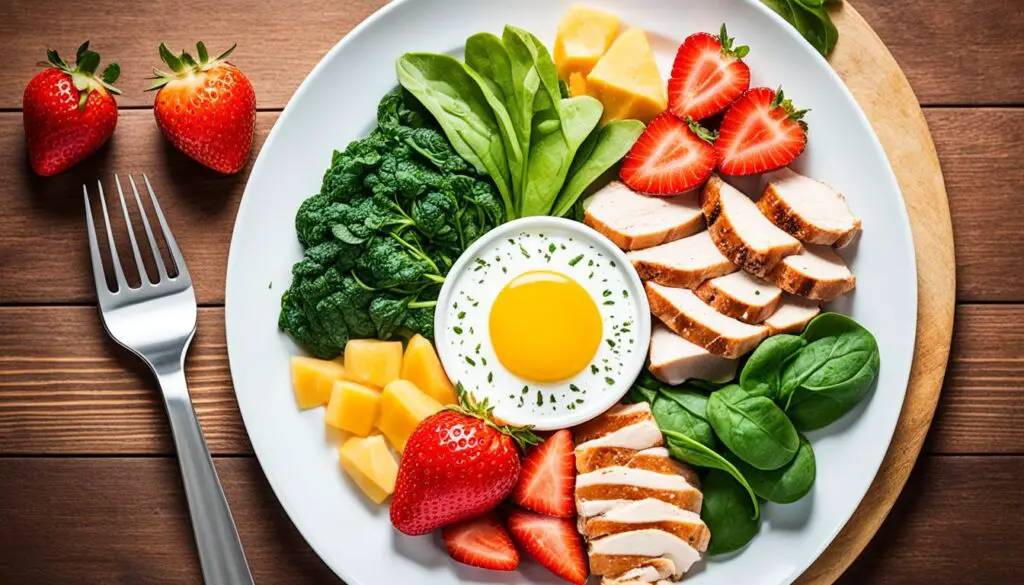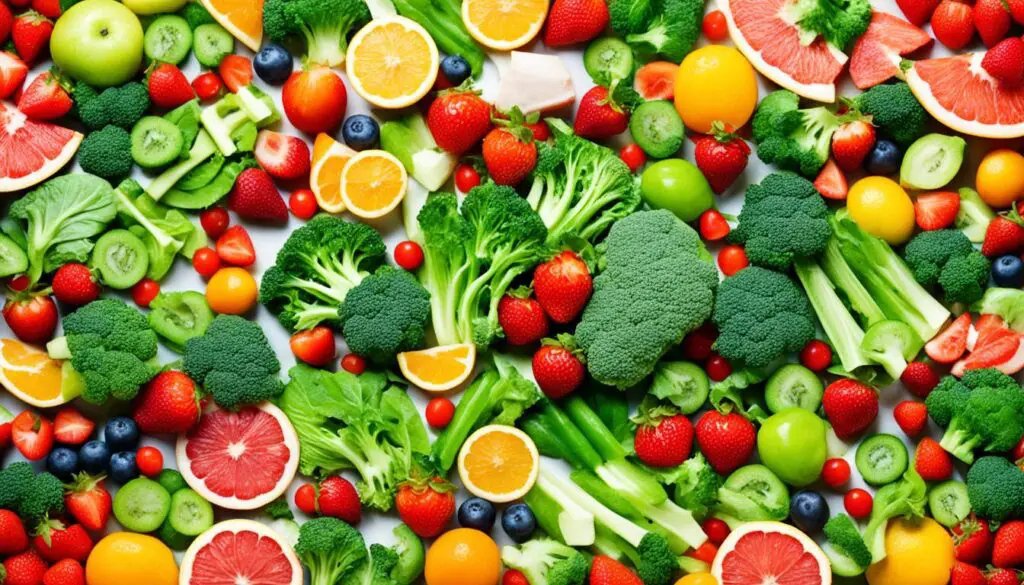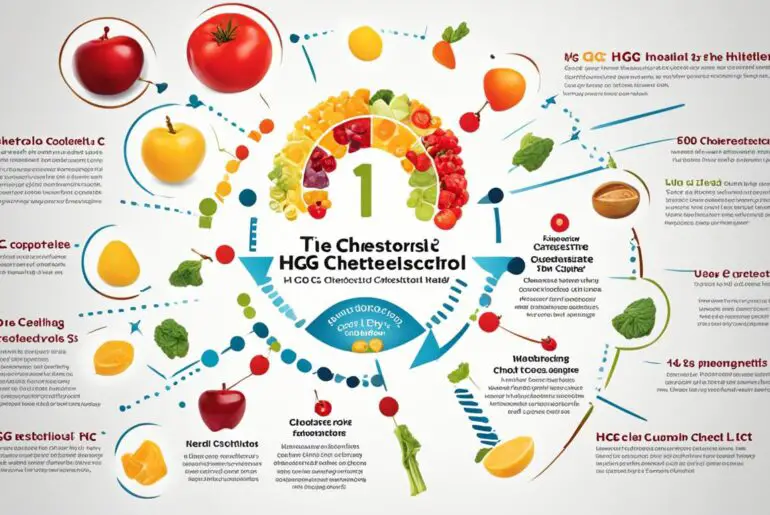Are you tired of trying countless diets and exercise routines without seeing significant results? Have you heard about the HCG Diet but wonder if it’s just another fad? Well, prepare to be amazed as I reveal the hidden truths behind the HCG Diet and its exercise guidelines. Get ready to discover the secrets to achieving sustainable weight loss and transforming your health.
Key Takeaways:
- Understand the different phases of the HCG Diet, including the loading phase, weight loss phase, and maintenance phase.
- Learn about the recommended calorie intake and food choices during each phase of the HCG Diet.
- Discover the role of exercise in the HCG Diet and how it can support long-term weight management.
- Explore plateau breakers and strategies to overcome weight loss stalls during the HCG Diet.
- Find out how to track your progress and measure success throughout your HCG Diet journey.
The HCG Diet
The HCG Diet, developed by Dr. Simeons, is a weight loss program that utilizes the HCG hormone to promote fat loss. This protocol consists of several phases, each with specific guidelines for calorie intake, food choices, and duration, to achieve optimal results. The goal of the HCG Diet is to facilitate rapid weight loss while preserving muscle mass, offering a comprehensive approach to achieving your weight loss goals.
First, let’s explore the different phases of the HCG Diet:
- Loading Phase: This initial phase involves a period of gorging or loading up on high-fat and oily foods while starting the HCG hormone. It prepares the body for the calorie restriction in the following phases.
- Weight Loss Phase: During this phase, calorie intake is restricted to either 500 or 800 calories per day, depending on the specific HCG protocol. The diet emphasizes lean proteins, vegetables, fruits, and starches from a predefined food list, ensuring balanced nutrition while promoting fat burn.
- Maintenance Phase: After achieving your weight loss goal, this phase allows for the gradual reintroduction of regular foods while avoiding sugars and starches. The aim is to stabilize your weight and solidify the progress made during the weight loss phase.
- Long-Term Maintenance Phase: Once you complete the initial phases, this final phase focuses on adopting sustainable lifestyle changes to support long-term weight management. It involves making healthy food choices, incorporating regular exercise, and practicing portion control.
By following the HCG Diet’s structured approach, you can experience rapid weight loss and establish healthy habits for long-term success.
Benefits of the HCG Diet:
“The HCG Diet offers a unique combination of the HCG hormone and a low-calorie diet, which can result in substantial weight loss while preserving lean muscle mass.” – Dr. Simeons
The HCG Diet’s benefits go beyond weight loss. Here are some key advantages:
- Promotes fat loss while preserving muscle mass
- Structured protocol that provides clear guidelines
- Rapid weight loss results
- Encourages healthy eating habits and portion control
- Supports long-term weight management through lifestyle changes
Is the HCG Diet Right for You?
While the HCG Diet has proven effective for many individuals, it’s important to consider various factors before starting any weight loss program. Consulting with a healthcare professional will help determine if the HCG Diet is suitable for you and your specific needs and circumstances.
Remember, successful weight loss requires a comprehensive approach that aligns with your body’s requirements and lifestyle. Explore different options and consider professional guidance to make informed decisions on your weight loss journey.
| Phase | Description |
|---|---|
| Loading Phase | Gorging/Loading on high-fat and oily foods while starting the HCG hormone |
| Weight Loss Phase | Calorie restriction to 500 or 800 calories per day with lean proteins, vegetables, fruits, and starches |
| Maintenance Phase | Reintroduction of regular foods while avoiding sugars and starches to stabilize weight |
| Long-Term Maintenance Phase | Adopting healthy eating habits, regular exercise, and portion control for long-term weight management |
Phase 1 – The Start
The Gorging/Loading phase marks the beginning of the HCG Diet journey. During this phase, individuals are advised to consume significant amounts of fatty and oily foods. This phase plays a crucial role in preparing the body for the subsequent calorie restriction in the following phases. The introduction of the HCG hormone is also initiated during this phase. Although considered one of the most challenging aspects of the diet, gorging/loading must be approached correctly to mitigate the occurrence of extreme hunger pains in the initial week of the diet.
The purpose of Phase 1 is to saturation load the body with excess calories while allowing the HCG hormone to accumulate in the body’s system. By indulging in fatty and oily foods, the body’s fat reserves are replenished and the hormone can effectively target and metabolize stored fat during the subsequent phases of the diet.
It is important to note that gorging/loading does not mean eating excessively without control. Rather, it involves eating to capacity with an emphasis on high-fat foods. Common food choices during this phase include avocados, butter, nuts, deep-fried foods, and other fatty sources. However, processed foods, refined sugars, and carbohydrates should be avoided during this phase.
Phase 1 sets the foundation for the HCG Diet, priming the body for the fat-burning phase to follow. It may be challenging at the early stages, but adhering to the guidelines and focusing on appropriate food choices will help prevent extreme hunger pains as the diet progresses.
Individuals embarking on the HCG Diet should consult with a healthcare professional before starting to ensure proper guidance and supervision throughout the journey.
The Gorging/Loading Phase – Key Points:
- Consume fatty and oily foods
- Avoid processed foods, refined sugars, and carbohydrates
- Prepare the body for calorie restriction
- Introduce the HCG hormone
By following the guidelines provided and embracing the Gorging/Loading phase of the HCG Diet, individuals set themselves up for eventual success in achieving their weight loss goals.
Phase 2 – Fat Burn

In phase 2 of the HCG Diet, also known as the Fat Burn phase, individuals embark on a calorie-restricted journey that requires strict adherence to a specific food list. During this phase, only 500 calories per day are consumed, which may seem challenging, but it is an integral part of the weight loss process. The combination of a low-calorie intake and the use of the HCG hormone, either through injections or nasal spray, stimulates the body’s metabolism and promotes fat burning.
To achieve the best results during phase 2, it is crucial to follow the HCG diet food list. This list outlines the specific lean proteins, vegetables, fruits, and starches that are allowed as part of the 500-calorie daily intake. By sticking to the recommended food choices, individuals can ensure they receive essential nutrients while maximizing the fat-burning potential of the HCG Diet.
| Food Group | Examples |
|---|---|
| Lean Proteins | Chicken breast, lean beef, white fish, shrimp |
| Vegetables | Spinach, lettuce, cucumbers, tomatoes |
| Fruits | Apples, oranges, strawberries, grapefruit |
| Starches | Melba toast, grissini breadsticks |
By selecting the right combination of foods from each group, individuals can create flavorful meals that help them stay satisfied throughout the day. It is important to note that portion sizes should be strictly controlled to ensure calorie intake remains within the prescribed range. Consulting the HCG diet food list and working with a healthcare professional can help individuals plan their meals and navigate phase 2 successfully.
What to Avoid While Taking HCG
While on the HCG Diet, it’s important to follow certain restrictions and recommendations to maximize your results. Here are some key things to avoid:
- Avoid oils in any form: This includes oils found in shampoos, lotions, toothpaste, makeup, and deodorant. Oils can interfere with the effectiveness of the HCG hormone and may hinder your weight loss progress. Opt for oil-free or mineral-based cosmetics to minimize any adverse effects.
- Avoid massages: Massages typically involve the use of oils and lotions, which can be absorbed by the skin and potentially interfere with the HCG hormone. During the diet, it’s best to avoid massages or opt for dry massages instead.
- Avoid sunbathing: Sunbathing can increase the risk of sunburn, especially if your skin is more sensitive due to the HCG diet. Additionally, prolonged sun exposure can lead to water retention, which may affect your weight measurements. Protect your skin by using sunscreen and limit your time in direct sunlight.
- Exercise in moderation: While exercise is not required during the HCG diet, it can be beneficial for overall health and weight management. However, it’s important to listen to your body and avoid intense or strenuous workouts. Start with light exercises such as walking or gentle yoga, and gradually increase the intensity as your body adjusts to the calorie restriction.
By adhering to these guidelines, you can optimize your HCG diet journey and increase your chances of achieving your weight loss goals.
Plateau Breakers

Plateaus can be frustrating when following the HCG Diet, causing a halt in weight loss progress. However, there are several strategies you can implement to overcome plateaus and continue on your weight loss journey.
Increasing Water Intake
One effective method to break through plateaus is by increasing your water intake. Staying hydrated promotes optimal body function and can help boost your metabolism. Aim to drink at least 8 glasses of water per day to stay adequately hydrated.
Modifying Protein Intake
Another technique to overcome plateaus is to modify your protein intake. This can involve adding or reducing small amounts of protein in your meals. Ensure that you are consuming lean sources of protein to support your weight loss goals.
Checking Condiments
It’s crucial to pay attention to condiments and seasonings used in your meals. Some condiments may contain hidden sugars or additives that can hinder weight loss progress. Check the labels and opt for condiments that are sugar-free and low in calories.
Eliminating Specific Food Items
In some cases, eliminating specific food items can help break through plateaus. Breadsticks, for example, are commonly associated with plateaus during the HCG Diet. If you find yourself at a standstill, consider removing breadsticks from your meals temporarily.
Consider Other Factors
Additionally, it’s important to consider other factors that may be contributing to plateaus. Ideal weight range, menstrual cycle, and medication changes can all impact weight loss progress. Take these factors into account and make necessary adjustments to your diet and lifestyle.
By implementing these strategies and staying consistent with the HCG Diet, you can break through plateaus and continue on your weight loss journey successfully.
Phase 3 – Maintenance Phase
During Phase 3 of the HCG Diet, also known as the Maintenance Phase, individuals transition from the strict dieting of the previous phases to a more flexible approach. The primary objective of this phase is to maintain the weight loss achieved in the earlier stages while stabilizing the body’s metabolism.
In Phase 3, individuals gradually reintroduce regular foods into their diet while avoiding sugars and starches. This phase typically lasts for three weeks and plays a vital role in establishing long-term weight management habits.
Allowable Foods
As individuals proceed with Phase 3, they can include a wider variety of foods in their daily meals. However, it is crucial to continue making mindful choices to support weight maintenance.
The allowable foods during this phase include:
- Lean proteins such as chicken, turkey, fish, and lean cuts of beef
- Fresh vegetables like broccoli, spinach, lettuce, and cucumbers
- Healthy fats such as avocados and olive oil
- Low-sugar fruits like berries and citrus fruits
- Nuts and seeds in moderation
- Whole grains and legumes in limited quantities
It is essential to focus on whole, unprocessed foods and maintain portion control to avoid weight regain during the maintenance phase of the HCG Diet.
Exercise Reintroduction
Another crucial aspect of Phase 3 is the reintroduction of exercise. With the guidance of a healthcare professional, individuals can gradually incorporate physical activity back into their routine.
The reintroduction of exercise serves multiple purposes, including:
- Supporting long-term weight management
- Improving cardiovascular health and endurance
- Increasing muscle tone and strength
- Enhancing overall well-being
It is important to consult with a healthcare professional or fitness expert to develop a safe and effective exercise plan tailored to individual needs and capabilities.
| Phase 3 – Maintenance Phase | Allowable Foods |
|---|---|
| Lean proteins | Chicken, turkey, fish, lean cuts of beef |
| Fresh vegetables | Broccoli, spinach, lettuce, cucumbers |
| Healthy fats | Avocados, olive oil |
| Low-sugar fruits | Berries, citrus fruits |
| Nuts and seeds | In moderation |
| Whole grains and legumes | Limited quantities |
Phase 3 of the HCG Diet provides individuals with an opportunity to transition into a more sustainable and balanced approach to eating while maintaining their weight loss. By reintroducing a wider variety of foods and incorporating exercise, individuals can embrace a healthy lifestyle for long-term weight management success.
Body Measurement Charts and Tracking
Tracking your progress is an essential part of the HCG Diet journey. By using measurement charts and weight tracking, you can monitor your body’s changes, overall progress, and stay motivated throughout the diet. It is recommended to measure key areas such as the bust, waist, hip, inner thigh, and bicep at the beginning of the diet and at regular intervals thereafter.
Tracking body measurements allows you to see the tangible results of your hard work and dedication. It provides a visual representation of your progress and can serve as a powerful motivating factor to continue pushing towards your weight loss goals.
Weight tracking is another crucial aspect of monitoring your progress. By recording your weight at regular intervals, you can track fluctuations, identify patterns, and assess the effectiveness of the diet. Remember, weight loss progress may not always be linear, and occasional plateaus are normal. However, tracking your weight will help you stay accountable and make adjustments as necessary.
Incorporating visual aids such as measurement charts and weight tracking can provide a tangible sense of achievement and reinforce your commitment to the HCG Diet. These tools allow you to track your progress systematically and objectively, giving you a clear understanding of how far you’ve come.
Measurement Chart Example:
| Measurement | Starting | Week 2 | Week 4 | Week 6 |
|---|---|---|---|---|
| Bust | 40 inches | 39 inches | 38 inches | 37 inches |
| Waist | 34 inches | 33 inches | 32 inches | 31 inches |
| Hip | 42 inches | 41 inches | 40 inches | 39 inches |
| Inner Thigh | 24 inches | 23 inches | 22 inches | 21 inches |
| Bicep | 12 inches | 11 inches | 10 inches | 9 inches |
This example demonstrates how tracking your measurements over time can reveal the positive changes happening in your body. Remember to update your measurement chart at regular intervals to accurately track your progress and celebrate your achievements along the way.
Tracking your progress with measurement charts and weight tracking provides concrete evidence of your success on the HCG Diet. It allows you to visually see the changes happening in your body and serves as a powerful motivator to keep going. Remember, every small step in the right direction counts towards reaching your weight loss goals.
Starting Measurements and Tracking Chart
![]()
Before beginning your journey with the HCG Diet, it is essential to establish a baseline by documenting your starting measurements. By measuring your bust, waist, hip, inner thigh, and bicep at the beginning, you can track your progress throughout the diet and gauge the changes in your body.
Additionally, tracking your weight is crucial for monitoring your daily progress and staying motivated. By keeping a daily weight tracking chart, you can record your weight measurements over time and visualize your accomplishments. This tracking chart allows you to identify any patterns or trends that may impact your weight loss journey.
Furthermore, it is beneficial to include notes or observations in your tracking chart. These notes can provide valuable insights into factors that may influence your weight loss, such as certain foods or activities. By documenting your experiences, you can make adjustments to optimize your results.
Sample Tracking Chart
| Date | Weight (lbs) | Notes |
|---|---|---|
| Day 1 | 180 | Starting weight |
| Day 2 | 178 | Feeling motivated and energetic |
| Day 3 | 176 | Noticed some water retention |
| Day 4 | 174 | Incorporated more cardio exercises |
| Day 5 | 172 | Feeling satisfied with food choices |
Using the provided sample tracking chart as a reference, create your own personalized chart to suit your needs. Remember to record your weight daily, include any relevant notes, and update it regularly to track your progress effectively. This visualization tool will serve as a source of motivation and help you stay on track towards achieving your weight loss goals.
Phase 4 – The Rest of Your Life

Phase 4 of the HCG Diet, known as “The Rest of Your Life” phase, is a crucial stage that focuses on long-term weight management and sustaining the results achieved during the diet. In this phase, you will transition from the strict diet plan to a more sustainable and balanced approach to eating and living. It involves making necessary lifestyle changes to maintain your weight loss and ensure a healthy future.
During Phase 4, you will actively incorporate healthy eating habits, regular exercise, and portion control into your daily routine. These lifestyle changes are essential for achieving long-term weight management success and avoiding weight regain. By adopting a mindful and balanced approach to your eating habits and overall lifestyle, you can solidify the healthy habits you have developed throughout the HCG Diet.
One of the key aspects of Phase 4 is adopting healthy eating habits. This includes focusing on whole, nutrient-dense foods and minimizing the consumption of processed and sugary foods. By incorporating a variety of fruits, vegetables, lean proteins, and whole grains into your meals, you can provide your body with the necessary nutrients while controlling calorie intake.
Regular exercise plays a crucial role in maintaining your weight loss and overall health in Phase 4. Engaging in physical activity not only helps burn calories but also boosts your metabolism, improves cardiovascular health, and enhances overall well-being. Aim for at least 150 minutes of moderate-intensity aerobic activity or 75 minutes of vigorous-intensity aerobic activity per week, along with strength training exercises to build and maintain muscle mass.
“Healthy eating and regular exercise are the cornerstones of long-term weight management.”
Another essential aspect of Phase 4 is practicing portion control. Paying attention to portion sizes allows you to maintain the balance between calories consumed and expended, helping you stay on track with your weight management goals. Be mindful of portion sizes, listen to your body’s hunger and satiety cues, and avoid overeating or mindless snacking.
Phase 4 of the HCG Diet sets the foundation for a lifetime of healthy habits and successful weight management. By embracing the lifestyle changes outlined in this phase, you can ensure that your weight loss is sustained in the long run and enjoy a healthier, happier future.
| Lifestyle Changes in Phase 4 |
|---|
| Adopting healthy eating habits |
| Incorporating regular exercise into your routine |
| Practicing portion control |
Allowable Foods and Recipes

When following the HCG Diet, it’s crucial to adhere to a specific list of allowable foods to ensure optimal weight loss results. These foods have been carefully selected to provide necessary nutrients while keeping calorie intake low. The HCG diet food choices include:
- Lean proteins: Chicken breast, turkey breast, white fish, shrimp, lean beef
- Vegetables: Spinach, lettuce, cabbage, cucumbers, tomatoes, asparagus
- Fruits: Apples, strawberries, oranges, grapefruit
- Starches: Melba toast, grissini breadsticks
By incorporating these allowable foods into your daily meals, you can stay within the recommended calorie range and promote fat loss while maintaining muscle mass. It’s important to note that portion control is key to ensuring the effectiveness of the HCG Diet.
To make the diet more interesting and flavorful, there are various HCG diet recipes available that provide meal ideas and variations. These recipes use the allowable foods in creative ways to add variety to your meals. Here’s a sample recipe to give you an idea:
Grilled Lemon Herb Chicken with Steamed Asparagus
Servings: 1
Ingredients:
- 100g chicken breast
- 1 lemon, juiced
- 1 teaspoon dried herbs (such as basil, thyme, or oregano)
- Salt and pepper to taste
- 5-6 asparagus spears
Instructions:
- Preheat grill to medium heat.
- In a small bowl, combine lemon juice, dried herbs, salt, and pepper.
- Marinate the chicken breast in the lemon herb mixture for 15-30 minutes.
- Grill the chicken breast for about 6-8 minutes per side, or until cooked through.
- While the chicken is grilling, steam the asparagus spears until tender-crisp.
- Serve the grilled chicken with steamed asparagus.
This recipe showcases how you can create delicious and satisfying meals while staying within the allowable foods of the HCG Diet. Remember to experiment with different ingredients and seasonings to keep your meals enjoyable throughout the diet.
Being mindful of the allowable foods and incorporating HCG diet recipes into your meal plan can help you stay on track and achieve your weight loss goals. However, it’s important to consult with a healthcare professional or nutritionist before starting any diet program to ensure it aligns with your individual needs and health conditions.
Conclusion
After considering the effectiveness and safety of the HCG Diet, it is clear that this weight loss program can produce results when followed strictly and under medical supervision. The combination of the HCG hormone and a low-calorie diet can potentially lead to significant fat loss while preserving muscle mass. However, it is crucial to note that the HCG Diet is controversial and not supported as a safe or effective approach by medical experts.
For individuals seeking weight loss success, it is important to explore other options that are both safer and more sustainable in the long run. Consulting with a healthcare professional before starting any weight loss program is highly recommended to ensure the chosen method aligns with individual health needs and goals.
In conclusion, while the HCG Diet may offer initial weight loss success for some individuals, it is crucial to prioritize overall health and well-being. Exploring alternative weight loss strategies that focus on healthy eating, regular exercise, and sustainable lifestyle changes may provide a more balanced approach to achieving long-term weight management.
FAQ
What is the HCG Diet?
The HCG Diet is a weight loss program that combines the use of the HCG hormone with a low-calorie diet. It aims to promote rapid weight loss while preserving muscle mass.
How does the HCG Diet work?
The HCG Diet works by utilizing the HCG hormone to promote fat loss. It consists of multiple phases, including a loading phase, a weight loss phase, a maintenance phase, and a long-term maintenance phase.
What is Phase 1 of the HCG Diet?
Phase 1, known as the Gorging/Loading phase, involves consuming as much fatty and oily foods as possible while starting the HCG hormone. This phase prepares the body for the calorie restriction in later phases.
What is Phase 2 of the HCG Diet?
Phase 2, the Fat Burn phase, involves consuming only 500 calories per day and using the HCG hormone. The diet restricts food choices to specific lean proteins, vegetables, fruits, and starches.
What should be avoided while taking HCG?
While on the HCG Diet, it is important to avoid oils in any form, including those found in cosmetics, as well as certain activities like sunbathing. Exercise should be done in moderation and adjusted based on individual capabilities and weight loss progress.
How can I break through plateaus while on the HCG Diet?
To break through plateaus, it is recommended to increase water intake, modify protein intake, check for hidden sugars in condiments, and eliminate specific food items. Factors such as ideal weight range, menstrual cycle, and medication changes should also be considered.
What is Phase 3 of the HCG Diet?
Phase 3, the Maintenance Phase, is where individuals gradually reintroduce regular foods into their diet while avoiding sugars and starches. Exercise can also be reintroduced during this phase.
How can I track my progress on the HCG Diet?
It is recommended to use measurement charts and weight tracking to monitor changes in body measurements, weight, and overall progress throughout the diet. This helps in visualizing progress and identifying any patterns or trends.
How do I document my starting measurements and track my weight on the HCG Diet?
Before starting the HCG Diet, document starting measurements such as bust, waist, hip, inner thigh, and bicep. Use a tracking chart to record daily weight measurements and any relevant notes or observations.
What is Phase 4 of the HCG Diet?
Phase 4, referred to as “The Rest of Your Life” phase, focuses on long-term weight management and maintaining the results achieved during the diet. It involves adopting healthy eating habits, incorporating regular exercise, and practicing portion control.
What foods are allowed on the HCG Diet?
The HCG Diet provides a list of allowable foods that can be consumed during the diet phases. These foods include specific lean proteins, vegetables, fruits, and starches. HCG diet recipes are also available for meal ideas and variations.
Is the HCG Diet safe and effective?
The HCG Diet is controversial and not recognized as safe or effective by medical experts. It is important to consult with a healthcare professional before starting any weight loss program to explore safer and more sustainable options.




